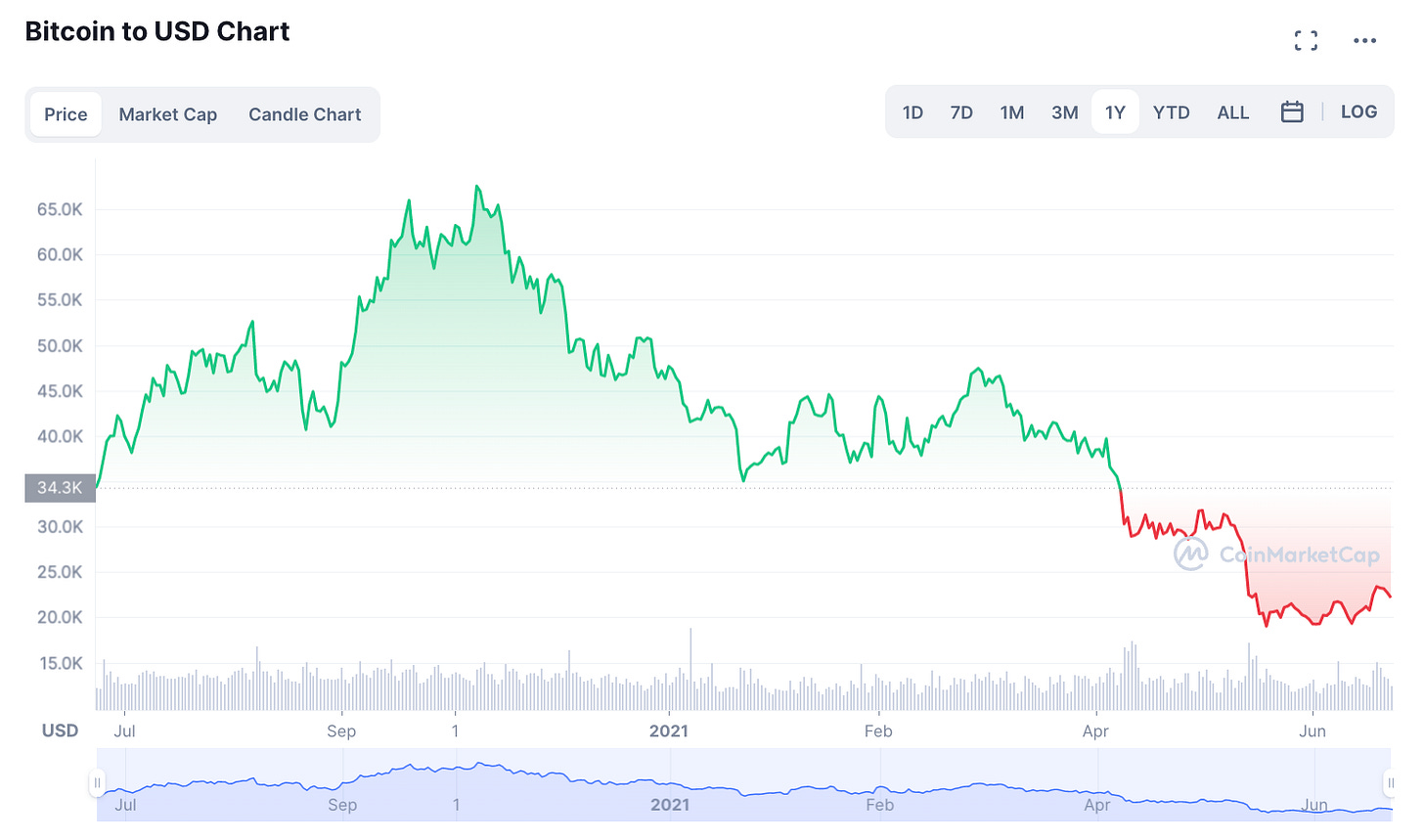How Long Will 'Bitcoin Winter' Last?
It depends how bad the Fed screws up
Since November Bitcoin’s been in yet another of its many character-building “Winters,” having fallen from $67,000 to below $19,000 before recovering modestly these past few days.
As I wrote in January, Bitcoin’s 2022 crash was predictable after the stock market crash that vaporized $5 trillion in equity value since the beginning of the year. Bitcoin follows stocks because Bitcoin’s price in this pre-monetization stage is partly the gold-like store of value Bitcoin is destined to become, but is mostly dot-com speculation that Bitcoin will become more popular — that it will become that very money.
So it’s a funny blend of value and growth.
This means that asking how long this Bitcoin Winter will last is really asking how long stocks will be down. Which very much depends how bad the Fed screws up.
Why Are Stocks Down?
Big Picture, equities are down because the Feds spent too much — over $6 trillion in deficits since the start of Covid, almost all obligingly turned into money at the Fed. Meanwhile, the Fed held rates too low too long, both to ease those deficits and to tranquilize voters into accepting lockdowns. Combined, fresh money and low rates led to 40-year highs in inflation.
In response, the Fed now wants to crash the economy so private spending goes down. In other words, squeeze the rest of us so the Feds can keep spending. The terminal point, in theory, could be a 1970’s-style crash from interest rates hitting double digits.
So it’s pretty simple, if pretty cruel. But the fly in the ointment is there wasn’t nearly so much debt in the 1970’s. Total debt today in the US is up to $88 trillion — $1.1 million per family of four. That’s up from $1.5 trillion in 1970. And, by the way, it’s up $35 trillion since 2008.
That much debt in the system — largely thanks to the Fed itself — means any sudden movements could break something important. And 2008 taught us nobody knows where those gremlins lurk. After all, 2008 was caused by little things almost nobody was even watching — Collateralized Debt Securities, Mortgage-Backed Securities. Tame little nothings that suddenly grew enormous fangs.
So the Fed’s takeaway is there are many gremlins lurking in the teetering financial behemoth it’s created, and it’s afraid.
Indeed, cracks have been appearing regularly ever since 2008. The 2013 “Taper Tantrum” and 2019 Repo Market pingpong were a warning to the Fed that it doesn’t really understand the markets that it, in theory, steers.
Today, we’ve already got serious storm-clouds from record moves in Reverse Repos, from the Japanese yen touching 40 year lows, from European sovereigns once again threatening default, and from consumer debt that soars even as GDP falls. Keep in mind these are just the gremlins we can see, not the ones the “experts” never see coming.
You’d think the Fed’s takeaway from these horrors would be maybe don’t run a global fiat cartel counterfeiting hundreds of trillions in paper. But of course they’re not paid to be careful custodians, they’re paid precisely to inflate as much as possible. So here we are.
When Does the Pain Stop?
With so many problems it’s hard to choose. Stocks are falling because of the inflation itself, the prospect of a Fed-induced recession, and the prospect of a 2008-style crash. We’re in a dicey spot at the moment: GDP is flirting with recession, with last quarter negative and this quarter touch-and-go. The Fed has never tried to hike into a recession starting so far behind the curve, so it is uncharted territory — more on that in a moment.
So we get four possible outcomes.
In order of simplicity, the cheeriest is a gradual reduction in inflation without recession or any major breakage — a “softish landing” in Powell’s words. In which case the pain is over, and markets are offering free money.
So far in this crash Bitcoin has moved about 2-3 times more than stocks, so in the “softish” scenario might expect stocks to jump, and Bitcoin to jump a lot more — say, $40,000-plus Bitcoin.
Next up, what if the Fed causes a regular recession? Well, so far this year the S&P has fallen 20%, while average peak-to-trough drop in a recession is 29%. So that would imply another 12% drop in stocks, and perhaps another 25-35% drop in Bitcoin.
And if this isn’t a normal recession, rather a 1970’s stagflation? Well, peak-to-trough in the 1970’s was 48%, implying a 35% drop from here in stocks, and perhaps 60-70% in Bitcoin.
And what if those financial market gremlins show up in force? In 2008 peak-to-trough was 57%. Implying another 46% from here on stocks, and closer to 70-80% on Bitcoin.
Finally, the Black Swan: a 1970’s stagflation mated with a 2008 crash. We haven’t seen one of these before, so all comps are off. To put a number on it, I guess more than 2/3 drop in stocks, and up to 90% drop in Bitcoin. I’ll talk more about the Black Swan outcome in future since it sets up some fun dynamics where Bitcoin would actually dramatically outperform. Still, the peak-to-trough would be epic.
Before jumping off that ledge, keep in mind all these numbers are measuring the absolute trough, the split-second when things are bleakest. So don’t panic, it won’t hurt as much as it looks. If you slept in the morning of the trough, or spent the week camping in Patagonia, you’d never even know it happened.
Given markets “want” to go up, in the sense that markets are made of profit-seeking individuals who usually fix faster than governments break, time usually heals all troughs.
Conclusion
How to protect yourself? Easy: sit it out. At least until we know better which outcome is likeliest. If you’re pathologically optimistic, put some long calls on SPY, but otherwise keep your powder dry. Strategic wait-and-see.
Then, going forward, if a recession starts or if something breaks in financial markets, expect both stocks and Bitcoin to drop further, perhaps dramatically. I’d guess this is most likely, near-term, and will eventually offer a helluva buying opportunity assuming they don’t terminally break the world.
On the other hand, if inflation moderates without a crash or breakage, then expect that boom right now: a recovery in both stocks and Bitcoin, perhaps dramatically so. So buy those long options.
Of course, if you believe Bitcoin will win — that fiat is doomed and that Bitcoin beats gold — then it really doesn’t matter: the perfect strategy is to do precisely nothing. Dollar-cost-average (DCA), buying little by little, gobbling up those precious Bitcoins at whatever discount the market’s gifting you. Then, with steely resolve, kick back and do absolutely nothing — DCA and Chill.
If you enjoyed this article, subscribe for free articles every week. And let me know your thoughts in the comments below.






